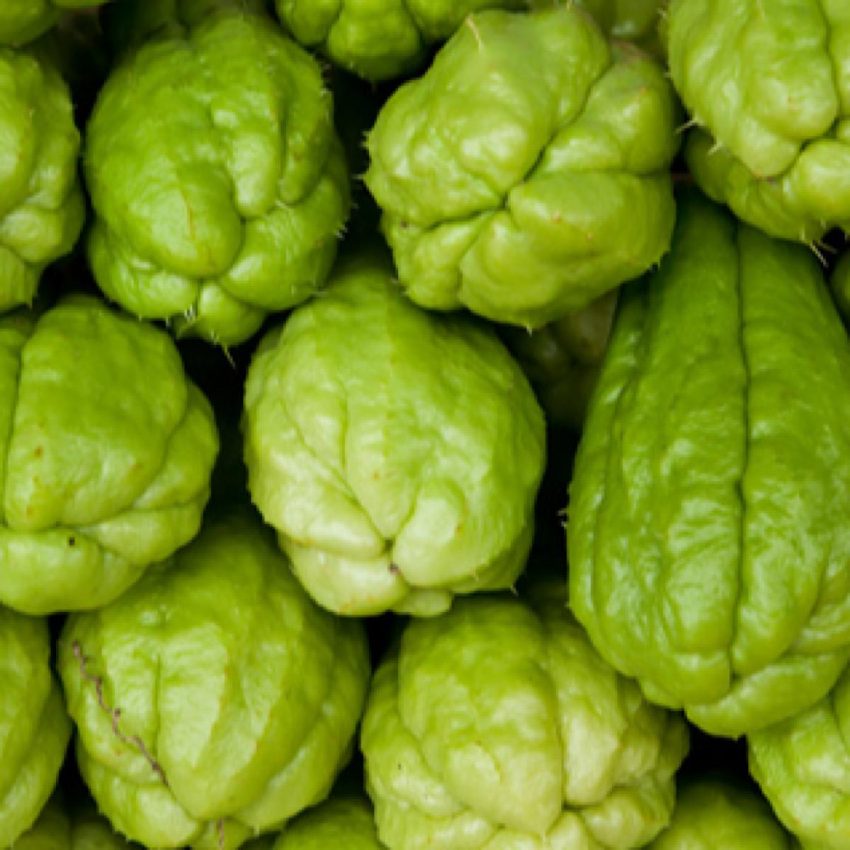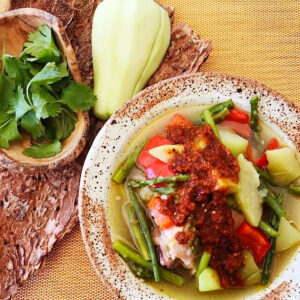Mexican mole sauces are easy to modify to low carb, but sometimes the vegetables typical of mole stews include potatoes or higher carb vegetables. This chicken mole amarillo (aka yellow mole) includes chayote and asparagus for vegetables, allowing the bright flavor of the mole sauce to really shine through without adding high carb vegetables.

Jump to: |RECIPE | Illustrated Steps for a Traditional Mole Sauce | How to Cook with Chayote
This post may contain affiliate links. As an Amazon Associate, I also earn from qualifying purchases. You can read our disclosure information here–
Illustrated Steps for a Traditional Mole Sauce
Here are the steps lined out with photos. For the details of the recipe itself, see the recipe card below.
A traditional mole is made with charred fresh peppers and can be time consuming. A quicker approach is to use dried peppers (rehydrated) which I have done in this recipe (see recipe card below). If you want an even easier version using mole spices instead of fresh or dried peppers, try this Yellow mole using a spice blend. Here is a visual summary of the directions for making a traditional mole sauce.

*Tip: After charring fresh peppers, tomatillos or tomatoes, you can close them inside a paper bag for a few minutes to steam. They should be easier to peel when removed.




What is Chayote?
Chayote (chai-OH-tay)is a pear-shaped, light green vegetable belonging to the gourd family. It has a crunchy texture and a mild, sweet flavor, similar to a summer squash.
Some people think it tastes like a cross between a cucumber and an apple. In fact, a lot of recipes use chayote as a substitute for apples in low carb apple strudel or pies.
The substitution of chayote for potatoes lends a slight crunch to the stew, which enhances the texture and overall flavor.
Chayote originated from Central America and is commonly found in Latin American grocery stores, it may be difficult to find in your neighborhood grocery store. I have found it year-round at Walmart.
The photo below is what ”fresh” chayote looks like.

Is Chayote Healthy?
Chayote is rich in fiber, antioxidants, iron, manganese, phosphorus, zinc, potassium, copper and vitamins B1, B2, B6 and C. It is a good food for easing acid reflux, and it is said to lower blood pressure.
Is Chayote Low Carb or Keto?
Although chayote isn’t necessarily as low carb as some other vegetables (like greens or broccoli), it’s definitely lower carb than potatoes and some other high-starch vegetables. Chayote is allowed on a low carb diet.
One whole chayote squash has 6 grams of carbs. However, it also has 2.2 grams of fiber, giving it a grand total of 3.8 net carbs.
See this post to learn more about the similarities and differences between Low Carb, Slow Carb and Keto diets.
How to Peel and Cut Chayote
Though chayote can be consumed raw and with the peel on, removing the peel and cooking the chayote helps to make it softer and more palatable.
To prepare chayote for the chicken mole recipe below, you need to peel off the skin, usually with a common vegetable peeler. It can then be cut into different sized pieces, depending on what you are making.
Most often you can cut the fruit down the middle and then cut the halves into quarters. This makes it easy to remove the large seeds by scraping it out with a knife or spoon.

How to Grow Chayote
Chayote is common in Central and South America and grows the best in tropical or sub-tropical environments. However, they are easy to grow compared to other perennial vegetables if you have a long growing season.
You can grow chayote in containers, however, the yield will not be as great as growing them in the ground. Sow the seeds 10 feet apart if growing in the ground.
They grow well with other squash, corn or peppers and can be complementary in cooking. Chayote are climbing plants, so you will want to trellis them or plant them near something they can climb on, like a fence.
If you’d like more tips on how to grow chayote, here is an article from The Survival Gardener. with videos and helpful growing hints.

Recipes Using Chayote
Chayote is very versatile. Similarly to other squashes, you can broil, bake, fry or eat chayote raw. You can toss it in salads or puree it in soups. Here are a few of our favorite dishes using chayote:
- Baked chayote “apple” crisp
- Pickled chayote
- Chayote and carrot coleslaw
- Roasted chayote with sheet pan or traybake dinners
- Chayote, tomato and cucumber salad
Chayote also pairs well with ground pork or beef, shrimp, or eggs. It would be a great ingredient in spring rolls or cabbage rolls with any of these ingredients!
If you enjoy all types of Mexican food, check out this category of ALL Mexican recipes, where you will find over 40 Mexican recipes, from casual, to low carb, to fancy.
Chicken Mole Amarillo with Chayote
Equipment
- bowls
Ingredients
- 3 dried guajillo chile peppers
- 1-2 dried ancho chile peppers
- 10 whole black peppercorns
- 4 whole cloves
- ¼ teaspoon cumin seeds
- 4 tomatillos unpeeled
- 1 firm Roma tomato quartered
- 1 onion unpeeled and cut into quarters
- 3 cloves garlic smashed
- 1 tablespoons olive oil
- 1 teaspoon salt
- 2 tablespoons cold water
- 2 teaspoons masa harina or white corn meal
- 4 cups chicken broth
- 6 large chicken thighs skinless and boneless
- 1 medium chayote peeled and sliced into large chunks
- 1 bunch fresh asparagus
- cilantro to taste, optional
Instructions
- Heat a large skillet over medium-high heat. Do not add oil to the skillet because you will be toasting ingredients rather than sautéing.
- First add all the dried chile peppers to the skillet and cook 2-3 minutes over medium-high heat, turning once. Remove from skillet and place on cutting board. Let them cool a bit and then cut peppers in half lengthwise and remove seeds. Place in a bowl and pour enough boiling water over the peppers to cover. Let them soak (rehydrate) for about 10 minutes.3 dried guajillo chile peppers, 1-2 dried ancho chile peppers
- While peppers are soaking, toast the peppercorns, cloves and cumin seeds for 1-2 minutes or until just fragrant. Remove from skillet and grind up in a spice grinder until finely ground.10 whole black peppercorns, 4 whole cloves, 1/4 teaspoon cumin seeds
- In the skillet, cook the tomatillos, tomato and onion about 7 minutes or until charred, turning occasionally. Add the garlic for the last minute or so. Remove everything from heat, let everything cool. Then peel the tomatillos and tomato. *note: you can put the tomatillos and tomato in a paper bag and close it up so that they steam for around 5 minutes. This will make them easier to peel.4 tomatillos, 1 firm Roma tomato, 1 onion, 3 cloves garlic
- Drain the chile peppers (reserving the chile water) and add the peppers, peeled tomatillos, tomato and onion to a food processor and process until smooth. Add the toasted spices and process until combined.
- In a medium saucepan, heat the oil over medium-high and add the processed pepper mixture and salt and bring to a boil. Reduce heat and simmer about 10 minutes.1 tablespoons olive oil, 1 teaspoon salt
- In a small bowl whisk together the water and corn meal and add to the simmering pepper mixture. Cook briefly until it reaches a low boil.2 tablespoons cold water, 2 teaspoons masa harina
- In a 6-quart Dutch oven, bring the 4 cups chicken broth to a boil. Add the chicken thighs and reduce the heat. Cover the pot and simmer about 15 minutes. Then add the chayote and asparagus. Simmer, covered 10-15 more minutes until chayote is tender.4 cups chicken broth, 6 large chicken thighs, 1 medium chayote, 1 bunch fresh asparagus
- To serve: Transfer the chicken thighs and vegetables to a plate with a slotted spoon (unless you want more of a soup) and spoon the mole over the chicken and vegetables. Garnish with cilantro if desired.cilantro
Notes
Nutrition
Online Diet/Health Coaching:
Although I am not currently taking clients for diet & health coaching, I was a coach for many years with the online service called coach.me. It is a great platform for all kinds of coaching – anything from specific diets, writing a blog, getting up early, or getting rid of that pesky procrastination.
There are some wonderful coaches and the testimonials will tell you what you need to know. Contact me at [email protected] to get a referral to some of the tested, experienced online coaches on Coach.me.



Leave a comment